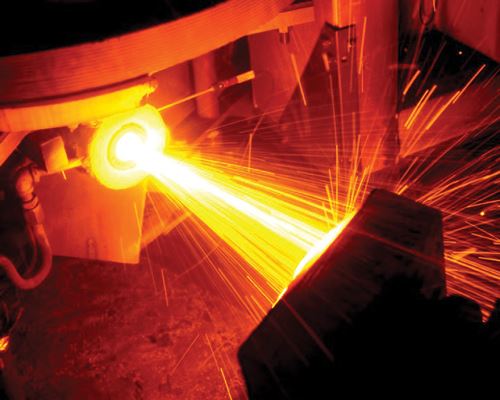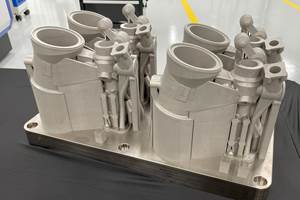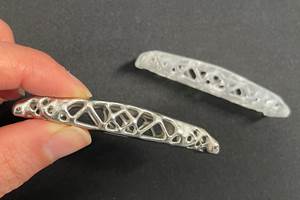Molten Spray Moldmaking
Rapid solidification creates mold and die tooling that is harder than heat treated components, within build times that are faster than machining.
[Editor's note: RSP Tooling, the company mentioned in the article below, no longer has a license agreement related to the Rapid Solidification Process (RSP). Premier Technology (www.ptius.com) now has a license agreement with Idaho National Laboratory related to RSP. A representative of Premier Technology told me the company's aim is to develop and sell machinery for producing large tooling and dies with this technology, but the timeframe for achieving this is unknown. Therefore, the article below is presented as information on an additive manufacturing approach that is likely to be available in the future. —PZ]
Because additive manufacturing processes are not affected by geometric detail, they ought to be ideal for making molds and dies. The complex features of these parts that slow down machining do not have to affect the speed of a process that builds parts layer by layer. However, size is a problem. Equipment for building additive metal parts is typically much more expensive than comparably sized CNC machine tools. Cost, among other factors, prevents additive equipment from scaling up to the size of a large mold or die.
Related Content
Postprocessing Steps and Costs for Metal 3D Printing
When your metal part is done 3D printing, you just pull it out of the machine and start using it, right? Not exactly.
Read MoreSeurat: Speed Is How AM Competes Against Machining, Casting, Forging
“We don’t ask for DFAM first,” says CEO. A new Boston-area additive manufacturing factory will deliver high-volume metal part production at unit costs beating conventional processes.
Read MoreWhy AM Leads to Internal Production for Collins Aerospace (Includes Video)
A new Charlotte-area center will provide additive manufacturing expertise and production capacity for Collins business units based across the country, allowing the company to guard proprietary design and process details that are often part of AM.
Read MorePossibilities From Electroplating 3D Printed Plastic Parts
Adding layers of nickel or copper to 3D printed polymer can impart desired properties such as electrical conductivity, EMI shielding, abrasion resistance and improved strength — approaching and even exceeding 3D printed metal, according to RePliForm.
Read MoreRead Next
At General Atomics, Do Unmanned Aerial Systems Reveal the Future of Aircraft Manufacturing?
The maker of the Predator and SkyGuardian remote aircraft can implement additive manufacturing more rapidly and widely than the makers of other types of planes. The role of 3D printing in current and future UAS components hints at how far AM can go to save cost and time in aircraft production and design.
Read More3D Printing Brings Sustainability, Accessibility to Glass Manufacturing
Australian startup Maple Glass Printing has developed a process for extruding glass into artwork, lab implements and architectural elements. Along the way, the company has also found more efficient ways of recycling this material.
Read MoreHybrid Additive Manufacturing Machine Tools Continue to Make Gains (Includes Video)
The hybrid machine tool is an idea that continues to advance. Two important developments of recent years expand the possibilities for this platform.
Read More
.jpg;width=70;height=70;mode=crop)




















